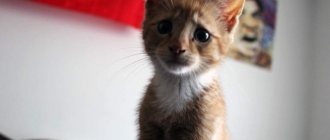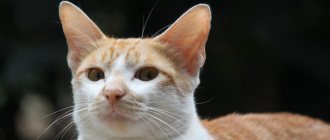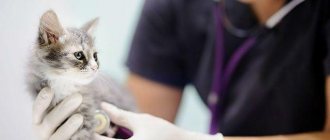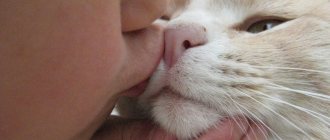Does it happen to cats?
Strabismus, or strabismus, can be diagnosed in cats at any age. The pathological process develops as a result of disruption of the eye muscles or nerve fibers. Strabismus can be a genetic feature, that is, it can be transmitted hereditarily. Siamese and Oriental breeds are considered prone to the disease.
Strabismus occurs:
- unilateral (one eye is deviated from the normal position);
- bilateral (there is a deviation from the visual axis of both eyes).
Depending on which eye is looking where, the following types of strabismus are distinguished:
- Esotropia, or convergent strabismus. Occurs most often. It manifests itself as a shift of the pupils towards the nose.
- Exotropia, or divergent strabismus. Characterized by dilation of the pupils towards the temples.
Strabismus, regardless of its type, is considered a deviation from the norm.
In Siamese, Thai and other breeds
There are no breeds in which all representatives have strabismus. Strabismus can be diagnosed in any cat. But there are breeds in which this pathology is diagnosed more often than others:
- Thai;
- Siamese;
- Javanese;
- oriental;
- Balinese;
- snowshoe.
Scientists believe that strabismus in animals occurs due to acromelanism, a manifestation of the gene that is responsible for coat color and eye color. But acromelanism can also disrupt the process of proper development of the optic nerve, which is why strabismus appears.
The pathological process of the organs of vision is not always treatable.
In kittens at an early age
At an early age, strabismus is often observed in kittens. This feature does not always indicate a physiological deviation.
Pupils looking in different directions may be evidence that the eye muscles have not yet had time to strengthen. This type of strabismus does not require treatment. In most cases, by 5 months the eyeballs are in the correct position.
If a kitten has congenital strabismus and has a genetic predisposition to such a feature, then the likelihood that the animal’s eyes will take the correct position is minimal.
It is recommended that your pet be seen by a doctor, but in most cases no medical intervention is required. The animal will be able to develop normally and live with this pathology. Hereditary strabismus does not cause any inconvenience or harm to the cat.
Cat Breeds Prone to Strabismus
Cats of any breed can have strabismus, but there are animals among which it is most common:
- Siamese;
- Thai;
- snow-shoe;
- Balinese;
- Javanese.
Cross-eyed Siamese cat
This phenomenon is associated with a special gene called “acromelanism”. It is he who gives cats an unusual color of fur and eyes (dark paws and tail, light body and bright blue eyes). But this gene gives cats not only beauty, because of it the optic nerve develops incorrectly, the cat sees everything in double form, and objects look flat. Attempts to put it all together and take a better look lead to the pet acquiring slanted eyes, sometimes the pupils move from side to side.
Causes
If strabismus is not a congenital defect, but appears at an early age or occurs later, its causes may be as follows:
- injuries (impacts);
- benign and malignant neoplasms;
- damage to the eye muscles;
- glaucoma;
- pathologies of the vestibular apparatus;
- infectious diseases;
- diseases of the nervous system;
- brain pathologies.
A veterinarian will help you find out the cause of strabismus and choose the appropriate treatment. Diagnosis includes collecting general information and examining the eyeballs. Additionally, an ultrasound, x-ray, magnetic resonance imaging or other examinations may be required.
Classification
In ophthalmology, several subtypes and forms of paralytic strabismus are distinguished. In terms of involvement of the eyes, it can be unilateral or bilateral, of the muscular system - isolated (with damage to a small area of one extraocular muscle) and widespread (with damage to two or more muscles). Based on pathogenetic characteristics, three forms of the pathological process are distinguished:
- Nuclear strabismus
is an acquired form of the disease in which the cause of abnormal tension or relaxation of the intraocular muscles is located in the intracranial nuclei. Most often, the source of their damage is a neurogenic infection: encephalitis, meningitis, multiple sclerosis, brain damage due to syphilis. This form of the disease is more often diagnosed in adults, and can also be congenital in nature (with intrauterine infection of the fetus, for example). - Stem (basal) strabismus
is another type of acquired pathology. It occurs due to damage to the nerve fibers and blood vessels associated with the extraocular muscles at the base of the brain. The source of the pathology is infectious or toxic destruction of brain tissue, head trauma at the base of the skull, anomalies of the arteries (sclerosis, aneurysm, etc.). - Orbital strabismus
is a form of the disease in which the source of the problems is located inside the orbit of the eye. The cause of abnormal tension of the extraocular muscles in this case is damage to the orbital bones, orbital abscess, tumors and other neoplasms. This form is considered the most favorable: after eliminating the source of the problems, the functions of the visual organs are restored quite quickly and in full.
Externally, paralytic strabismus of different forms does not differ from each other. Since during the diagnostic process the doctor needs to find out what exactly needs to be corrected to restore the anatomy and physiology of the eye, it is necessary to differentiate individual types of the disease.
Treatment
For treatment, the animal may be prescribed medications, but the possibility of surgical intervention cannot be ruled out. Therapy depends on the type and cause of the pathology.
Most often, drug therapy is prescribed to animals with infectious lesions. After suppressing the inflammatory process, the position of the eyeballs returns to normal. All medications, their dosage, duration of treatment are prescribed by a doctor.
Operation
Surgery is performed when drug therapy cannot eliminate the cause of strabismus, for example, if there is a tumor or damage to the eye muscles.
If surgery is recommended for your animal, the procedure should not be delayed. The sooner the surgery is performed, the higher the chance of treatment success.
At home
If the cat is prescribed drug therapy, treatment can be carried out at home. The owner can care for the animal. Your cat may need:
- rubbing the eyes;
- taking pills;
- use of painkillers.
If the doctor has prescribed IVs or injections, it is not necessary to hospitalize the cat. Many veterinary clinics offer home visits.
Traditional methods
If the cat squints only in one eye, then you can try to correct the position of the visual organ with a bandage. The animal needs to close its healthy eye every day. The bandage is applied for several hours.
Traditional methods can be combined with traditional treatment. For example, when diagnosing inflammatory processes, you can make lotions that are prepared from chamomile decoction. Traditional medicine can help eliminate the pathology, but provided that there are no indications for surgical intervention.
Before using unconventional methods, you should consult your veterinarian.
Mister Cat talks: famous cross-eyed cats
Due to the fact that cats with strabismus look touching and special, their owners do not miss the opportunity to show everyone around their special pet.
For example, the popular cat Spangles from South Carolina. His squint does not in the least prevent him from living life to the fullest, having fun and posing for the camera in various outfits.
Spangles
Spangles
Spangles
Spangles
Spangles
And here is a ginger cat from California named Jarvis. He was found by his current owners on the street at 4 weeks of age. Apparently, the previous owner, having noticed a flaw in the kitten in the form of slanted eyes, decided to get rid of it in this way. The cat was picked up by a local resident and at first wanted to give him to a shelter, but then she changed her mind and kept the baby with her.
Jarvis
Jarvis
Cat Jarvis gained fame and was loved by millions of people when his owner posted his photos on the Internet. People couldn't ignore such a charming and funny ginger cat. And Jarvis’s owner herself says that the cat has been incredibly smart, active and cheerful since childhood, and she is very glad that she did not give him to a shelter.
Jarvis
Jarvis 1111
Prevention
To prevent your cat from developing strabismus, it is necessary to undergo an annual preventative examination at a veterinary clinic. If any diseases are detected, treat immediately. You should also contact a veterinarian if the animal has problems with coordination, has had a head injury, or the integrity of the eyelid tissues has been compromised.
The animal should not be allowed to walk unattended or have contact with other people's cats. This can lead to conflict, and the pet may get hurt as a result of the fight.
Congenital strabismus cannot be prevented in breeds that are prone to this feature.
Clinical picture and diagnosis
First, one or both of a cat's eyes can point in any direction. In some cases, the movement of the pupils is completely uncoordinated; they move “on their own.” But this is rare. This happens either when “combined” with nystagmus (in Thai cats), or with serious neurological pathologies.
This is also indicated by an enlarged or constricted pupil, unsteady walking, tilting the head to one side, and frequent collisions with interior objects. Serious behavioral pathologies or neurological seizures are possible. In severe cases, appetite may decrease, sometimes leading to coma (cancer, encephalitis).
As a rule, when making a diagnosis, they focus on clinical manifestations, and this is quite enough. But here it should be remembered that acquired strabismus is often only a symptom indicating much more serious problems. These are the ones that need to be identified during diagnosis.
Treatment of entropion in cats
Entropion, or entropion of the eyelids in a cat, is treated surgically or “almost surgically.”
In the event that entropion of the eyelids occurs in a kitten (the author has encountered such problems in sphinxes), temporary sutures may be applied. The purpose of this manipulation is to create a scar that will not allow the eyelids to roll back. The advantage is that the manipulation is performed under general anesthesia. There are more disadvantages: the seams may come off prematurely and will have to be re-stitched; the stitching itself is also stressful for the animal. Temporary suturing is not effective in adult animals. Also, for temporary correction, injection of hyaluronic acid into the eyelid can be used. This measure allows you to temporarily straighten the eyelid, thereby giving your pet time to grow.
All adult cats are recommended for full eyelid surgery. For each entropion, several types of blepharoplasty have been invented, so the ophthalmologist chooses the technique based on what kind of entropion the cat has and what its degree is. Eyelid surgery in cats is always performed under general anesthesia. In our clinic, this is always inhalation anesthesia with the addition of an analgesic, and the duration of plastic surgery rarely exceeds 30 minutes for both eyes.
Recovery period after blepharoplasty in cats:
As in Hollywood, after surgery our patients experience swelling and inflammation of the eyelids, which subside within a few days with therapeutic treatment. This unpleasant, but short-lived torment is worth the end result!
The photo was taken immediately after the operation. Note swelling of the eyelids and conjunctiva. This is a normal condition for several days after surgery. Photo taken immediately after surgery. Note swelling of the eyelids and conjunctiva. This is normal for several days after surgery
To prevent self-injury, wearing a protective collar is recommended. 14 days after the operation, the stitches and collar are removed, and the animal returns to its normal lifestyle. In animals lacking fur, a small scar may be visualized. To make this scar less noticeable, we use thin but durable suture material that does not cause inflammation.
Photo 14 days after the sutures were removed. There is still some slight swelling. Within 2-3 weeks, the eyelid will completely return to normal. Slight redness and abrasions left by the thread will heal in a few days. The scar is minimal. After 2-3 weeks, new fur will fully grow.
Result 1 month after surgery










